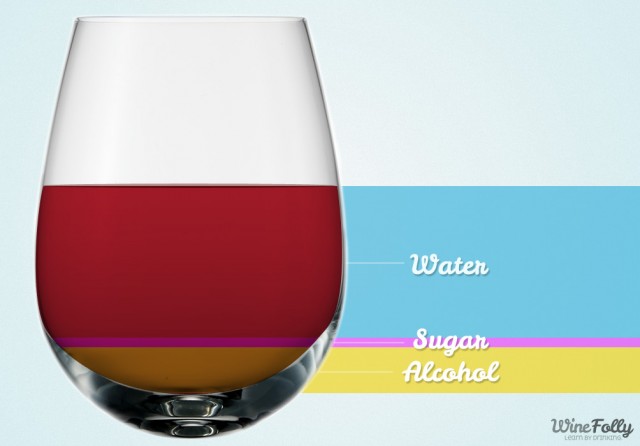I used to drink a half-bottle to a full bottle of wine every night. Despite this delicious habit, I had to cut down because of the calories in wine.
There Are Calories in Wine (eek!)
Depending on the wine, one glass of wine can range between 92 – 300 calories. The range has to do with alcohol content, inherent sweetness of the wine, and serving size.
The following information will give you some familiar examples of wines and how many calories they have by the glass. I’m not advocating you drink only low-calorie wine, but it never hurts to be familiar with the calorie count.
Wine contains 92–300 calories per serving.

Understanding Calories in Wine
Alcohol is Very High in Calories Per Gram
The highest calorie wines tend to have the highest alcohol content. Alcohol has 7 calories per gram versus carbohydrates (sugar), which have 4 calories per gram. This means some sweet wines have less calories than some dry wines! Dry wines are commonly considered to range from around 11% alcohol to about 14%. However, a quick check of alcohol percentages of wines at the grocery store shows that many dry wines often exceed 15%. A standard 6 oz glass of dry wine with 15% alcohol has 175 calories.
Super high alcohol sweet wines, like Port, Tawny Port & Banyuls, are a double whammy of sugar-carb calories, plus alcohol calories. Neutral grape spirits are used in Port wine to halt the yeast from eating the sugars, leaving the sweetness in the wine. Port has 20% ABV and around 100 g/L of residual sugar. A standard 2 oz glass of port has 103 calories.
Sugar in Champagne & Sparkling Wines
Champagnes and sparkling wines have added sugar and alcohol. The added amount is called “le dosage,” and it’s added during the champagne making process. The dosage can range from nothing (aka “Brut Nature” or “Brut Zero”) to sweet (aka “Doux”) with up to 50 g/L of sugar. The laws on the Champagne region in France require the wines to be no more than 12.5% alcohol. However, non-Champagne bubbly ranges from very light, at around 9% alcohol, to high, at 15%. For a standard 5 oz pour, Champagne ranges from 124 calories (Brut Zero) to 175 calories (Doux).
Wine Calories Comparison Chart



Wine Calories From Least to Most (6 oz pours)
- German Spatlese Riesling (Dr. Hermann “H” 2009)
- 110 calories, bottle 495 calories
- Slightly Sweet Lambrusco (Lini 910)
- 140 calories, bottle 630 calories
- Cabernet Sauvignon from France
- 160 calories, bottle 720 calories
- German Auslese Riesling
- 160 calories, bottle 720 calories
- Cabernet Sauvignon from California
- 175 calories, bottle 788 calories
- California 16% Zinfandel (Bob Biale)
- 190 calories, bottle 855 calories
- Australian Shiraz (Mollydooker The Boxer)
- 190 calories, bottle 855 calories
- Chateau d’Yquem
- 270 calories, bottle 1215 calories (note: standard serving size is only 2 oz which is 90 calories)
- Ruby Port
- 310 calories, bottle 1395 calories (note: standard serving size is only 2 oz which is 103 calories)
- Tawny Port
- 320 calories, bottle 1440 calories (note: standard serving size is only 2 oz which is 106 calories)
Calories in Wine Come From Carbs and Alcohol
Wine is mostly water, and alcohol, carbohydrates, and trace minerals(1). The carbohydrates come from the residual sugar left in the wine. Dry wines have less than 3 grams/Liter, and sweet wines typically range from 20-150 g/L (some can have up to 300 g/L!). A late harvest dessert wine may have about 150 g/L of sugar compared to Coca-Cola at 111 g/L and Maple Syrup at 700 g/L(2). To determine the total calories in a bottle of wine, add the calories of alcohol with the calories of carbs.
Conclusion From a Wine Geek
Sweet wines like Riesling and Lambrusco have less calories per glass than most Cabernet Sauvignon. However, you may drink more because they are also lighter in alcohol!
Even though a late harvest dessert wine like Chateau d’Yquem has much more residual sugar than a can of Coca-Cola, you’re not likely to drink as much because the serving size is about six times less.
If you’re on a diet, don’t despair with just one glass of wine. You can skip dessert and use the same amount of calories for 2-3 servings of dessert wine. Oh… and… I’m not your doctor, so check with him/her first if you have serious health issues. Yep!

